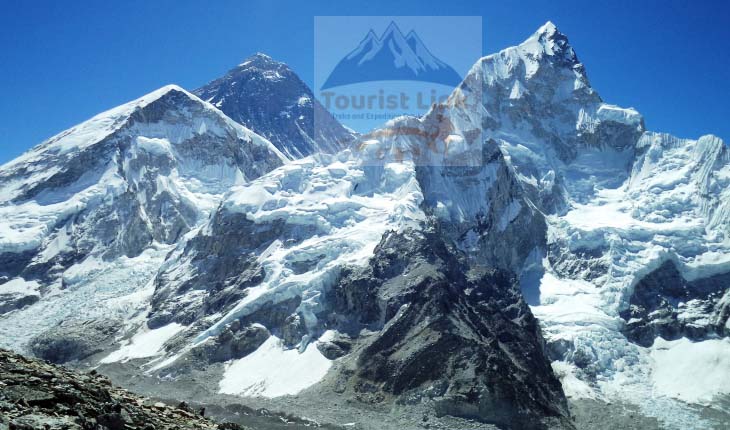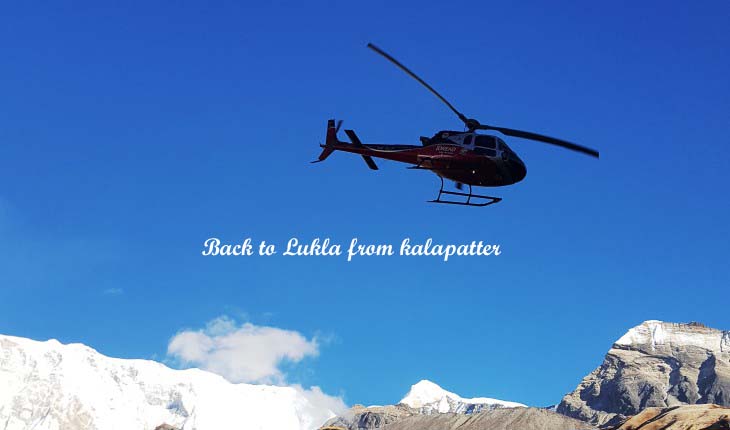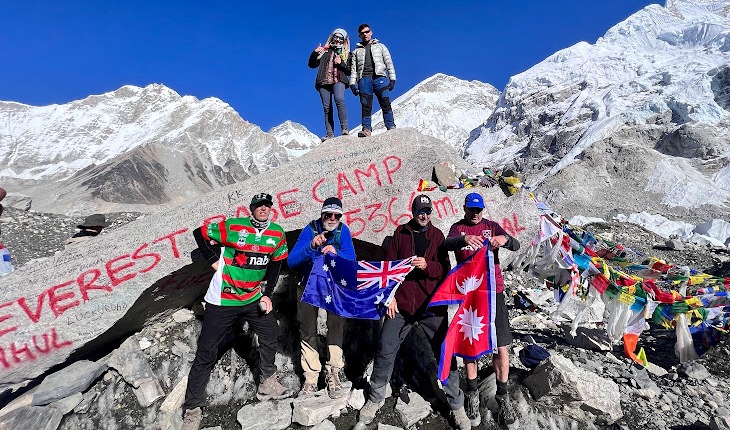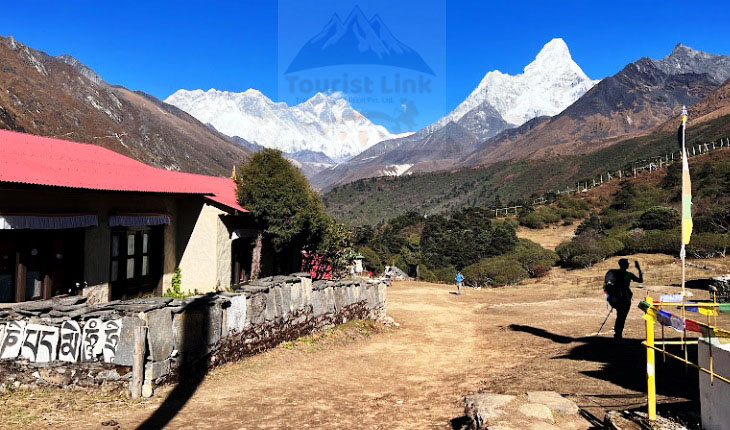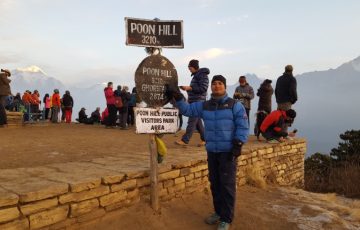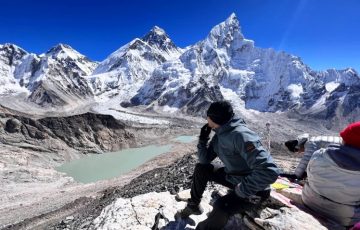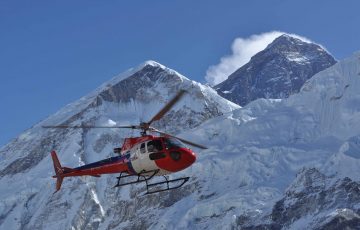Trip Facts
+2 People above
Hard
Mountain Lodge
5500m
(Breakfast/Lunch/Dinner)
Private vehicle/Flight/Helicopter
Trip Highlights
- Scenic Himalayan flight to Lukla world-renowned airport.
- Explore Sherpa culture.
- Visit the ancient monastery.
- Visit Tengboche monastery one of the oldest from Everest region.
- Nepali, Tibetan, Indian, and international cuisine.
- Experience Mountain Lodge.
- Fly Back by Helicopter through the Himalayas.
- Wildlife observation at Sagarmatha National Park (UNESCO) world heritage site.
- Birdeye view of Mt Everest and Khumbu glacier from Kalapathar 5545m.
Trip Overview of Everest Base Camp Trek 7 Days
Everest Base Camp trek 7 Days Days which sounds quite strange because it normally takes around two weeks. Tourist Link Treks and Adventure came up with the idea of organizing it within seven days. This one-week journey takes you to EBC and comes back from there with a scenic helicopter flight back to Kathmandu.
Nowadays because of the busy work schedule, people do have not enough time for a multi-week trekking journey thus Tourist Link Treks & Adventure started to organize this trip to fulfill your dream of exploring Everest Base Camp Trek in one week. The only difference between a regular Everest Base Camp Trek and Everest Base Camp Trek 7 days are of time duration otherwise you can explore everything that a regular EBC trekker experiences. And another special feature of this journey is you can enjoy a bird-eye aerial view while coming back to Kathmandu which is so beautiful.
First, we fly to Lukla from Kathmandu taking small propeller aircraft. Then we trek to Everest Base Camp exploring the village and mountain along the way. We visit Everest Base Camp and climb Kalapathar 5550m from where we can see a very clear view of Mt Everest, Khumbu glacier, Mt Lhotse, Mt Nuptse, and dozens of other mountains. We take a Helicopter from Gorakshep 5160m and fly back to Kathmandu.
Everest Base camp trek-7 days complexity
The journey to the Everest Base Camp trek is for sure a challenging task that requires physical fitness and little hiking experience. If you consider doing some physical workout and cardio exercise before coming to the Everest trek it will be way easier than you think. We do it steadily taking a significant amount of acclimatization which makes it easier than you think. In short, we can say it’s challenging but not very difficult. The season of this trek is September to December, and March to May.
Introduction:
Embark on an exhilarating 7-day journey to conquer Everest Base Camp, a unique trekking package by Tourist Link Trek & Expedition designed for those with limited time yet robust physical conditions. Ideal for athletes accustomed to altitudes above 3500m, this adventure is crafted to deliver the essence of Everest in a week. Endorsed by major travel portals, this trek follows the historic ascent of Mt Everest in 1953 by Sir Edmund Hillary and Tenzing Norgay Sherpa. Nestled in UNESCO-listed Sagarmatha National Park, Everest Base Camp offers a stunning canvas of legendary peaks, including Everest at 8,848m. Beyond landscapes, immerse in Sherpa culture, adding a cultural dimension to the trek. Explore scenic flights, and diverse trekking options like Everest Three Pass, Gokyo Lake, and Chola Pass, tailoring the adventure to your preferences. The Everest region beckons with a rich tapestry of nature and culture for an unforgettable experience.
Itinerary:
Day 01: Fly Kathmandu to Lukla 2840m, Trek to Phakding / 30 min flight, 3-hour trek.
Day 02: Trek Phakding to Namche 3440m / 6-hour trek.
Day 03: Trek Namche to Pangboche 4200m / 6-hour trek.
Day 04: Trek Pangoche to Thogla 4620m / 5-hour trek.
Day 05: Trek Thogla to Lobuche 4900m / 3-hour trek.
Day 06: Trek Lobuche to Gorakshep 5160m, Visit Everest Base Camp,/ 6-hour trek.
Day 07: Early morning visit to Kalapathar 5545m / Helicopter flight back to Kathamandu from Gorakshep 5160m
Scenic flight to the Himalayas:
Embark on an unforgettable adventure with our 'Scenic Flight to the Himalayas' experience. Departing from Kathmandu, our thrilling small aircraft ride to Lukla unveils the rugged beauty of the Himalayan panorama—towering peaks, terraced hillsides, and meandering rivers. Marvel at traditional houses along the route for a picturesque view. The return journey offers an up-close encounter with the majestic Himalayas and Nepal's captivating hills. This extraordinary airborne expedition promises both adventure and awe-inspiring scenery, creating the perfect blend for an unforgettable journey. Immerse yourself in the beauty of the Himalayas with our scenic flight experience!
Explore Everest Region:
Explore the allure of the Everest region, nestled in UNESCO-listed Sagarmatha National Park. Discover towering peaks and vibrant Sherpa culture in this natural wonderland, home to rich flora and fauna, from Himalayan thars to elusive snow leopards. Immerse yourself in unique customs and ancient traditions for a detailed experience of this UNESCO World Heritage site. Tourist Link Trek's Everest Base Camp trek elevates your adventure, offering unparalleled beauty, cultural richness, and wildlife encounters. Secure your slot today for an unforgettable journey into the heart of the Himalayas. Join us for an experience that blends nature, culture, and adventure seamlessly!
Sherpa People and Culture:
Explore the resilient Sherpa tribe in Everest, known for mountaineering prowess and high-altitude adaptation. Followers of Tibetan Buddhism, Sherpas infuse spirituality into the Himalayan landscape. Ancient monasteries, adorned with prayer flags, Mani walls, and stupas, dot the trail, revealing centuries-old traditions. The vibrant atmosphere resonates with energy, offering an immersive journey into Sherpa culture, spirituality, and profound customs shaping the breathtaking Everest tapestry. Immerse yourself in the Sherpa way of life, surrounded by prayer flags and ancient monasteries, on a journey that blends tradition, spirituality, and the stunning backdrop of the Everest region.
Ancient monastery exploration:
Immerse yourself in the cultural richness of the Everest region, adorned with monasteries, nunneries, stupas, chortens, and Mani walls. These sacred sites showcase the depth of Sherpa culture and their spiritual legacy. Each village reveals monasteries with stunning Buddhist Thangka paintings, portraying Vajrayana deities in vibrant hues like gold and silver. To delve even deeper into Sherpa heritage, the museum in Namche Bazaar offers a captivating journey through artifacts and exhibits, providing a comprehensive understanding of the Sherpa people's cultural and religious significance in the heart of the Himalayas. Explore the Everest Base Camp trek, where every village unfolds beautiful monasteries, such as Tengboche Gumba, Pangboche Gumba, Thame Gumba, Khumjung Gumpa, and Ani Gumba in Deboche at 3800m. Immerse in Sherpa culture on a journey enriched with spiritual landmarks and captivating history.
Observe Mt Everest:
Ascend to the pinnacle of the Everest Base Camp Trek with breathtaking views from Kalapathar at 5545m. While glimpses of Mt Everest punctuate the trek, Kalapathar provides an unmatched advantage. This exclusive vantage point ensures an iconic experience, offering an awe-inspiring view of the world's tallest peak at 8848m. Revel in the majesty of Everest, crowning your journey with unparalleled grandeur. Witnessing the towering peak from Kalapathar distinguishes the Everest Base Camp Trek, making it a truly remarkable adventure. Elevate your trekking experience with this iconic viewpoint, capturing the essence of Everest's magnificence.
Experienced Guide:
At Tourist Link Trek & Expedition, we prioritize your trekking experience by providing seasoned guides for an unparalleled journey. Our professional, skilled, and knowledgeable guides have a down-to-earth approach, ensuring a seamless adventure. We give precedence to local Sherpa guides, born and raised in the Himalayan highlands, offering a unique insight into the region. A seasoned guide is a crucial advantage, ensuring a disruption-free trip. All our guides undergo thorough training in guiding, first aid, and emergency scenarios, guaranteeing a secure trekking experience. Trust us to make your trek memorable with our expert guides, making every step of your journey safe and enjoyable.
Booking Information:
For booking please contact us via e-mail and WhatsApp. Contact detail are given below.
WhatsApp: +977-9851268523
Email: touristlinktreks@gmail.com
Safety and Logistics:
Visit our website's FAQ section for detailed insights on safety and logistics. Discover essential information, from safety measures to recommended trekking gear, weather details, and emergency protocols. Your safety is paramount, and our comprehensive FAQ is designed to prepare you thoroughly for your trek. Delve into this resourceful section for valuable insights, and don't hesitate to reach out for any additional assistance. We are dedicated to ensuring your journey to the Everest region is both secure and enjoyable.
Testimonial:
Discover glowing reviews from our delighted clients on top social media platforms and esteemed travel portals like Lonely Planet and TripAdvisor. Our commitment to exceptional service is reflected in the overwhelmingly positive feedback from past travelers. As we aim for continued excellence, explore firsthand accounts of memorable journeys and outstanding service. Join us on our quest to uphold and enhance this legacy, ensuring even more efficient and delightful adventures in the days ahead. Your satisfaction is our priority, and we look forward to exceeding your expectations on your next journey with us.
Conclusion and Farewell:
Embark on an extraordinary Everest Base Camp adventure with Tourist Link Trek & Expedition, where we redefine the trekking experience with unparalleled comfort. Enjoy plush accommodations featuring warm, cozy rooms, relish delectable meals, and receive unwavering support from our dedicated guide and porter team. At Tourist Link Trek and Expedition, service quality is our priority, earning us a reputation for excellence and positive client feedback. Join us for a journey led by professional, knowledgeable, and down-to-earth guides, providing an in-depth exploration of Everest Base Camp and a lifetime of adventure. Your comfort and satisfaction are at the forefront as we strive to make your trek an unforgettable and enjoyable experience.
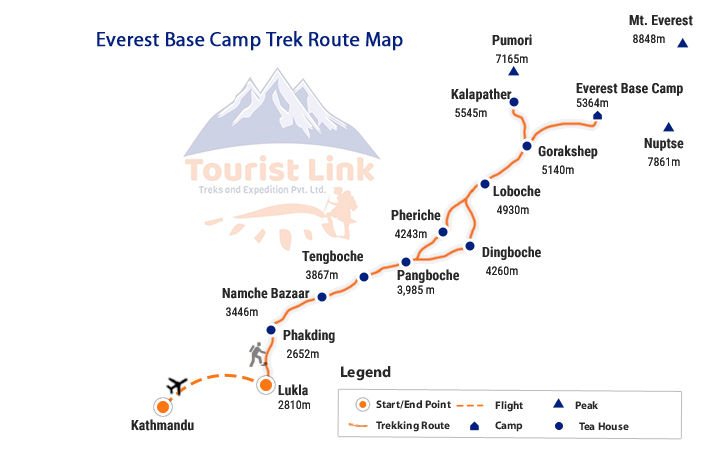
Itinerary
Day 01 Fly Kathmandu to Lukla and trek to Phakding 2600m
30 min flight and 3 hrs trek (Lunch/Dinner) Mountain Lodge
Your adventure kicks off as your guide meets you at your hotel in the early morning. A quick 10-minute drive takes you to the airport. After the necessary check-in procedures, you embark on a scenic Himalayan flight to Lukla (2840m), a journey of approximately 30 minutes. Welcomed by your porter upon arrival, you collectively transport your baggage to a nearby hotel. Here, the guide provides insights into the journey, essential guidelines, and introduces you to the porter. The trek commences with a descent towards Phakding, traversing a picturesque stone-laden trail. En route, you pass through charming Sherpa villages like Cheplung, Chaurikharka, and Ghat, eventually reaching Ghat village alongside the turquoise Dudhkoshi River. A delightful lunch awaits at Thadokoshi village, complemented by stunning views of Mt Kusumkangaro.
Day 02 Trek Phakding to Namche
6-hour (Breakfast/Lunch/Dinner) Mountain Lodge
Embarking on your trek after a wholesome breakfast around 8 a.m., the trail follows the Dudh Koshi River, weaving through numerous villages. Along the way, feast your eyes on a panorama of mountains, including Thamserku (6608m), Kusum Kangaroo (6367m), Kwangde (6168m), Nuptse (7861m), Taboche (6367m), Cholatse (6335m), Khumbi-yulha (5761m), and the majestic Mt. Everest (8848m). Crossing suspension bridges, a stop at Monjo marks your entrance into the national park, where your guide handles permit formalities. Relish lunch at Jorsalle (2740m) with a breathtaking backdrop of rivers, jungles, and waterfalls. Donkeys, trekkers, and porters create a lively scene. Beyond the Larja Dovan high suspension bridge (2830m), a stone-laden staircase ascends to Namche. En route, the Everest viewpoint reveals captivating sights of Mt. Everest (8848m) and Nuptse (7861m). The shaded trail leads to Namche (3440m), where you rest overnight in a mountain lodge, also known as a tea house.
Day 03 Trek Namche to Pangboche 4200m
6-hour (Breakfast/Lunch/Dinner) Mountain Lodge
Commencing our trek after a hearty breakfast, we navigate a trail that ascends sharply for the initial 20 minutes, leveling off to a path elevated above the terrain. Revel in breathtaking vistas featuring Mt. Amadablam (6856m), Everest (8848m), Lhotse (8414m), Taboche (6367m), Cholatse (6335m), Thamserku (6608m), and Khangtega (6685m). Descending after Sanasa, we reach Phunki Tenga (3250m) by the Dudhkoshi River, where we pause for a nourishing lunch. Ascending through switchbacks, the proximity to Mt. Khangtega (6685m) unfolds, alongside panoramic views of Namche and Khumjung. Encounter the Himalayan Thar, a wild goat species, while approaching Tengboche. This revered site boasts stunning backdrops of Mt. Everest and Mt. Amadablam. Tengboche's ancient monastery hosts daily worship rituals, creating a sacred and mystical ambiance. A six-hour trek concludes at a mountain lodge, offering an overnight stay.
Day 04 Trek Pangboche to Thogla 4620m
6-hour (Breakfast/Lunch/Dinner) Mountain Lodge
Embarking on the day's trek after a nourishing breakfast, the trail unfolds uphill towards Somare (4010m), characterized by yak pastureland and herder shelters. Ascending gradually, a captivating view of Mt. Amadablam (6856m) emerges prominently. Continuing the journey, Pheriche (4240m) is the next settlement, where a pause for lunch allows for absorbing the surrounding mountainous panorama. Beyond Pheriche, the landscape becomes sparser in vegetation, offering an unobstructed 360-degree view of mountains, prominently featuring Mt. Amadablam and Lhotse. The route encounters numerous yaks and their herder shelters, contributing to the enchanting ambiance. Once a farming village, Pheriche has transformed into a tea house town, with seasonal farming persisting during summer. The day concludes with an overnight stay at a mountain lodge, encompassing a six-hour trek to Thokla (4410m).
Day 05 Trek Thogla to Lobuche 4900m
3-hour (Breakfast/Lunch/Dinner) Mountain Lodge
Continuing the trek, we embark on the journey to Lobuche (4900m) after a hearty breakfast. The trail initiates with an uphill ascent to cross the Thokla-La pass (4830m). Subsequently, the path winds through the moraine route alongside the bank of the Khumbu glacier. Along this route, numerous memorials stand as tributes to climbers and trekkers who met their fate in this formidable region. Plaques dedicated to legendary climbers dot the landscape. The panoramic view encompasses majestic mountains such as Khumbutse (6665m), Lingtren (6749m), Chumbu (6859m), and Lobuche Peak (6119m). The trek duration is approximately 3.5 hours, culminating in an overnight stay at a mountain lodge.
Day 06 Trek Lobuche to Gorakshep 5160m
3.5 hrs (Breakfast/Lunch/Dinner) Mountain Lodge
Embarking on our journey early in the morning after a nourishing breakfast, we traverse the gully formed by a glacier. The trail ascends a small pass known as Lobuche pass, leading above a glacier laden with loose rocks and gravel. It's essential to pace yourself at this altitude, adjusting to the diminishing oxygen levels. The hike offers breathtaking views of the spectacular Himalayan panorama, providing constant rejuvenation. Upon reaching Gorakshep, we take a well-deserved rest, indulge in a hearty lunch, and proceed to explore Everest Base Camp (5365m). The path navigates along the mountain's lower edge beside the glacier, revealing a landscape filled with rock, ice, gravel, and massive chunks of ice. Mt Pumo Ri (7165m) stands tall above, creating a stunning backdrop. After spending time at the base camp, we return to Gorakshep.
Day 07 Early morning hike to Kalapathar 5550m and fly back Kathmandu
3 hrs trek and 1.2 hrs chopper flight (Breakfast/Lunch)
Ascending Kalapathar (5550m) before sunrise, we embark on a journey to witness an unparalleled close-up view of Mt Everest. Nestled in the heart of the Khumbu Everest Himalaya, Kalapathar, meaning "black rock," offers a vantage point for a 360-degree panorama of Everest, Khumbu valley, and the daunting Khumbu icefall. The detailed and close-up perspective of Mt Everest from Kalapathar contrasts with its appearance from the base camp. The ascent, taking 3-4 hours round-trip, culminates with a rewarding breakfast. Subsequently, we prepare for a breathtaking helicopter ride back to Kathmandu, savoring the mesmerizing aerial views of the picturesque countryside during the 1.5-hour journey.
What's included?
- Guide and Porter
- All meals during the trek
- Mountain lodge
- Transport to airport for pick and drop
- All necessary permits
- Flight cost
- Helicopter charge
What's not included?
- Bottled water
- All soft and hard drinks
- International airfare
- Travel insurance
- Tips for guide and porter
- Hot shower and battery charge
Fixed Departures
| Start Date | End Date | Price | Availability | Booking |
|---|
Everest Base Camp trek within a week.
Essential Information
When to Go?
March to May and mid-September to November are ideal times to go on trekking in Nepal. However, you can do the trek throughout the year, excluding harsh winter and heavy monsoon periods for better experiences. Read more.....
Gear Checklist
Gears and equipment assure your safety and smooth trekking experiences as you enter the Himalayas. With essential equipment, you can add some of the other specific ones which most probably will come in handy in during the trek. A reliable preparation from your side is a positive step for successful trekking and climbing expedition. Read More...
Food, drinking water, and accommodation facilities
The menu for everyday foods gets slimmer with a significant rise in altitude. One can always find a warm tea and basic local staple in the lodges or teahouses operating here. Natural drinking water sources, as well as Drinking water taps, are available throughout the trail. Accommodations might lose even some of the basic facilities as we move higher up in the trails of the Himalayas. Read more...
Trip Permit
To enter and trek the protected and restricted segments of Nepal, you will have to take special permits from the government of Nepal for the sole purpose of preserving the people and nature of these areas. Read more...
Altitude Sickness
Altitude sickness is one of the primary concerns while trekking in areas of higher altitudes. You must be prepared and act quickly if the symptoms appear during the trek. Using some prevention techniques, you can slow down and minimize the symptoms of Altitude sickness up to some extent. Read more...
Physical condition and experience requirements
Different types and levels of trekking might require a certain minimum fitness level to accomplish. With the guides, you can make up for the segments lacking the experience in trekking. Nepal also offers a lot of different varieties of the trek which the trekkers of any age or physical condition can do. The selection of an optimal trekking program is best for both parties. Read more...
Weather
Weather in the Higher Himalayas is always unpredictable. Regular monitoring and contact help us to be safe from any unforeseen change of weather in most cases. With the presence of a licensed guide, you can take the correct destinations and make the most of the trek. Read more...


